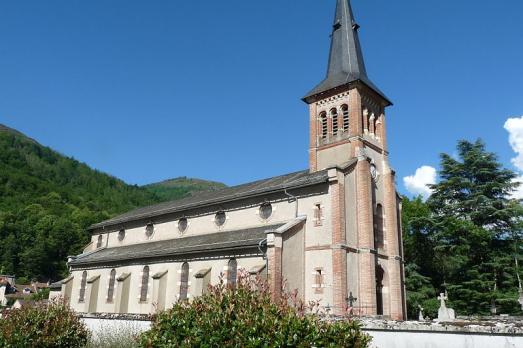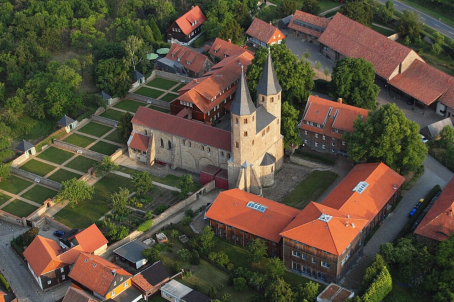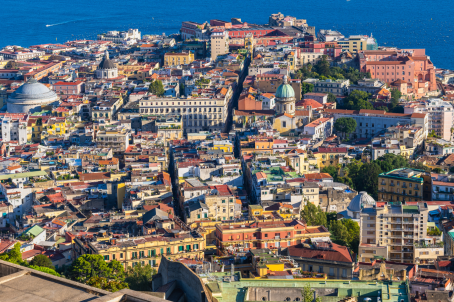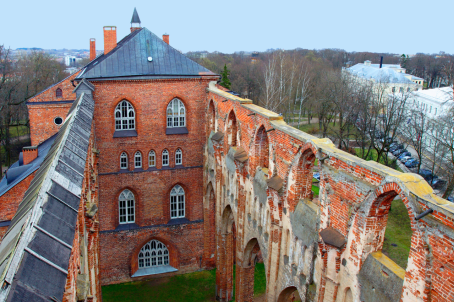
Church of Saint Volusien, Savignac Les Ormeaux
Savignac-les-Ormeaux , FR
The current building is dated 1901, and construction was completed in 1904, in a neo-Romanesque style.
Here you can search for a building to visit. You can use the map find destinations, or you can use the filters to search for a building based upon what different criteria.

Savignac-les-Ormeaux , FR
The current building is dated 1901, and construction was completed in 1904, in a neo-Romanesque style.

Petit-Sart (Lierneux), BE
The current Neo-Romanesque construction dates from the second half of the 19th century and replaces an old chapel. It is characterised by a play of volumes inherent in the Mosan architecture of the 11th and 12th centuries.

Widehem, FR
The church of Saint-Wulmer was built in the 15th century by the monks of the abbey of Samer, founded in the 7th century by Saint Wulmer, one of the sons of the Count of Boulogne.

Brinay, FR
Building of modest dimensions, with a simple plan consisting of a rectangular nave followed by a choir of the same plan and preceded by a canopy or caquetry. What makes this church particularly interesting are its Romanesque mural paintings discovered in the choir in 1911-1912. Through a thorough study of the style of the movements, clothing and hairstyle of the peasants, the date of the paintings could be fixed around the middle of the 12th century.

Ivoy-le-Pré, FR
The St Aignan church was located inside the walls of the medieval village of Ivoy-Le-Pré in the 13th century, which was ruined and pillaged by the Huguenots. In the 16th century the single nave church was extended by a five section chevet, and then enlarged by the addition of side chapels with beautifully ribbed vaults, forming a transept. Today, the bays of the church are adorned with stained glass windows (Lorain studio) and one can admire many classified objects.

La Haye de Calleville, FR
The Saint Aignan-Sainte Clothilde church in La Haye-de-Calleville, France, Normandy was founded in the 11th century by the lords of Harcourt. Built of flint with stone buttresses, it was originally dedicated to Saint Aignan. In the 17th century, the church underwent a transformation and was placed under the patronage of Saint Clotilde.

Breidfeld (Weiswampach), LU
The church of Saint-Alphonse was built in 1840 and was the first to provide Breidfeld with a place of worship. In 1930 two bells were installed in the tower, the oldest of which was damaged during the Rundstedt offensive in 1945 and replaced by a new one in 1947.

Saint-Amand-Montrond, FR
The church's style, both Romanesque and Gothic, is due to the confrontation of two cultures, that of the north of Aquitaine and that of the south of Ile de France. The church has also undergone numerous restorations, partial reconstructions or successive additions over the centuries. Thus, between the 11th and 20th centuries, the church has not known a century without structural changes.

Olette-Evol, FR
The Church of Saint-André d'Olette is located in Olette-Evol in Occitania. The early church dates back to Romanesque times (12th century). It was then dedicated to the Blessed Virgin. Enlarged in the sixteenth century, it is composed of a three bay nave that is framed by two side aisles and separated from the nave by arches. The nave is extended by a square choir with a flat chevet. Among the furniture, many objects are classified as Historical Monuments.
Angoulême, FR
Built from the 12th century, it is one of the oldest churches in the city, with St. Peter's Cathedral nearby. Seriously damaged during the Hundred Years' War, a major modernization campaign is implemented in the second half of the fifteenth century.

new
Nestled amidst the serene landscapes of the Harz region, lies a hidden gem for nature enthusiasts and history buffs alike - the Harz Monastery Hiking Trail. Lace up your hiking boots and embark on this captivating adventure that will transport you back in time.

The Holy Mile (Miglio Sacro) of Naples is a one-mile-long itinerary, through sacred places linked to the city's patron saint, San Gennaro, in the Rione Sanità district. Discover the city from a new perspective with this unique walking tour.

As a university city, cultural offerings abound in Tartu and will reach their peak after being designated one of three European Capitals of Culture for 2024. In this list, we've compiled the most interesting sacred places to visit in and around the old town.